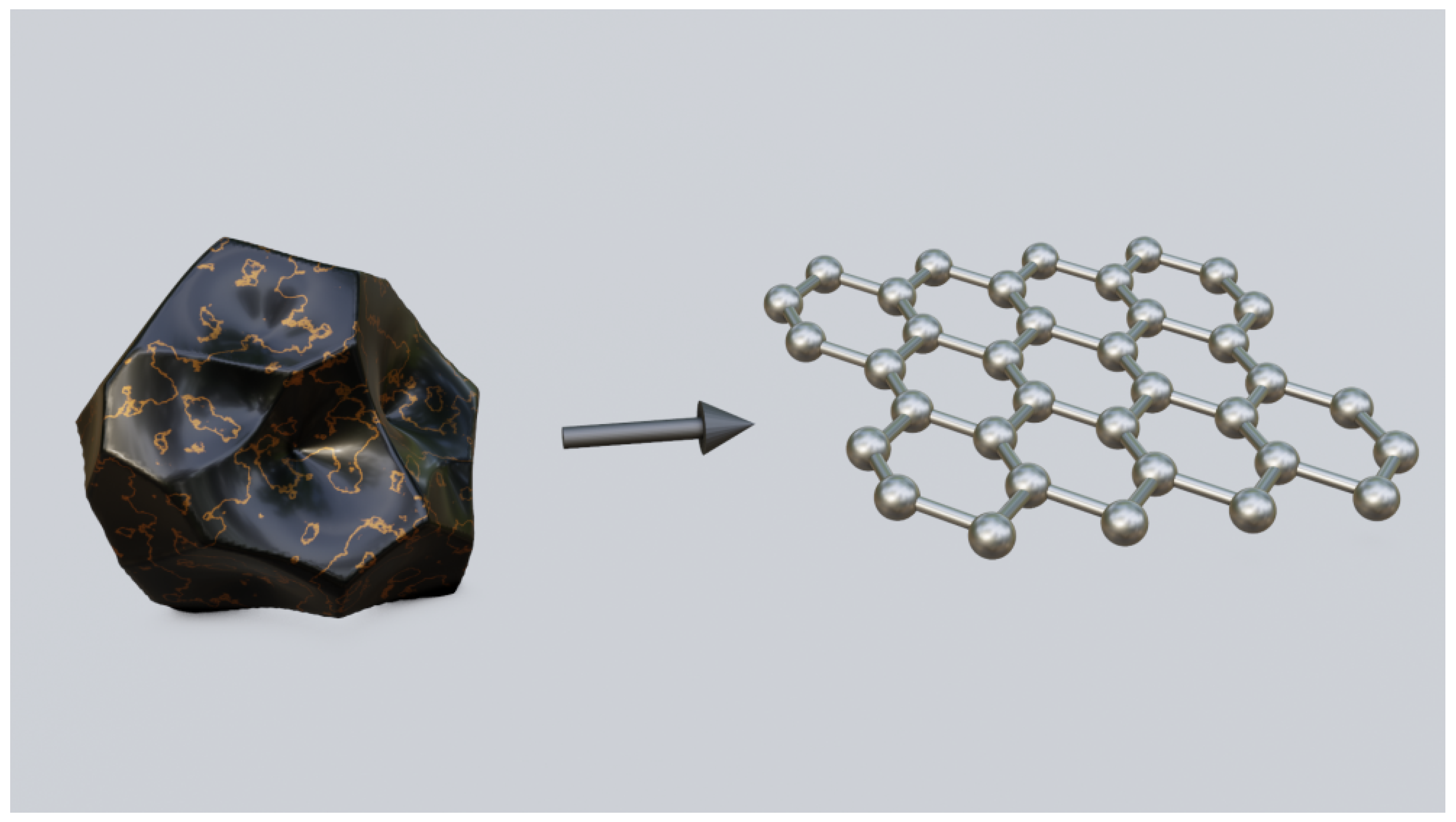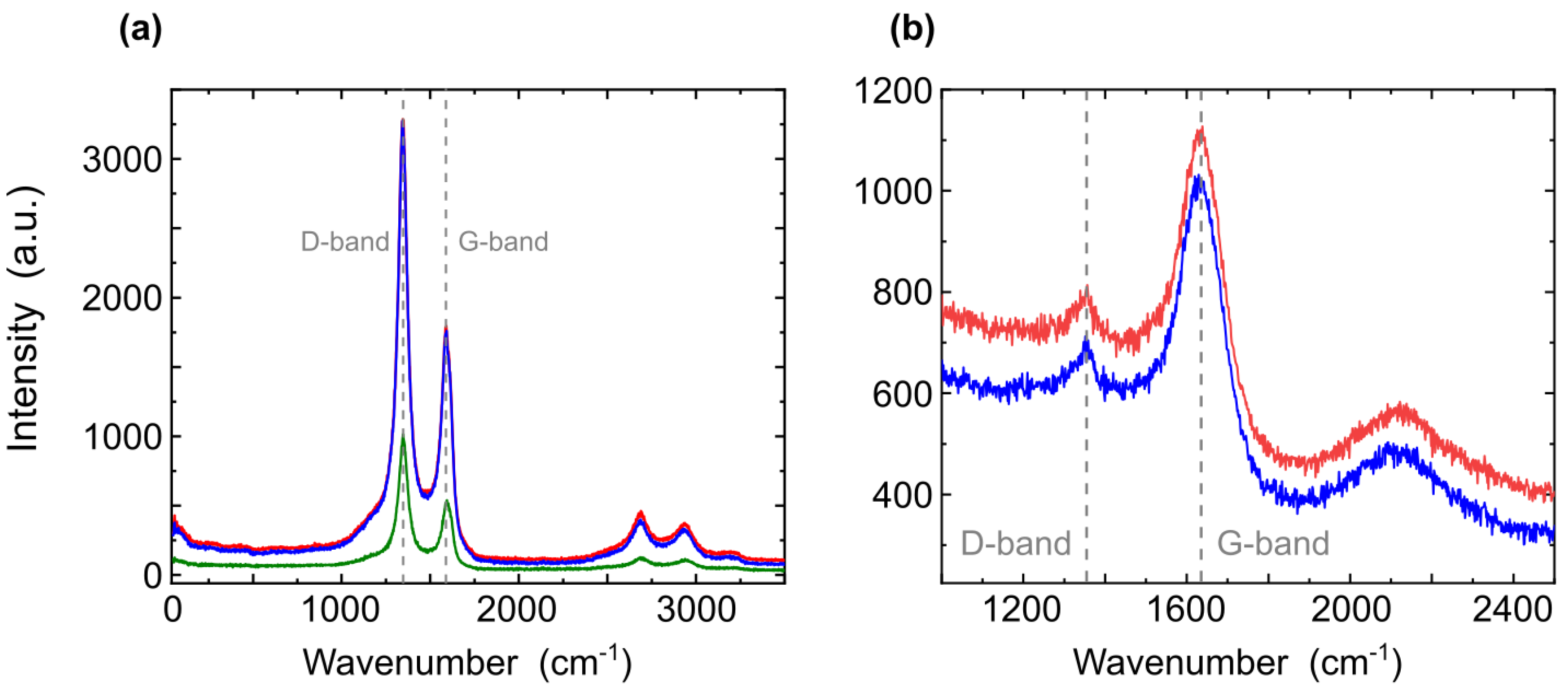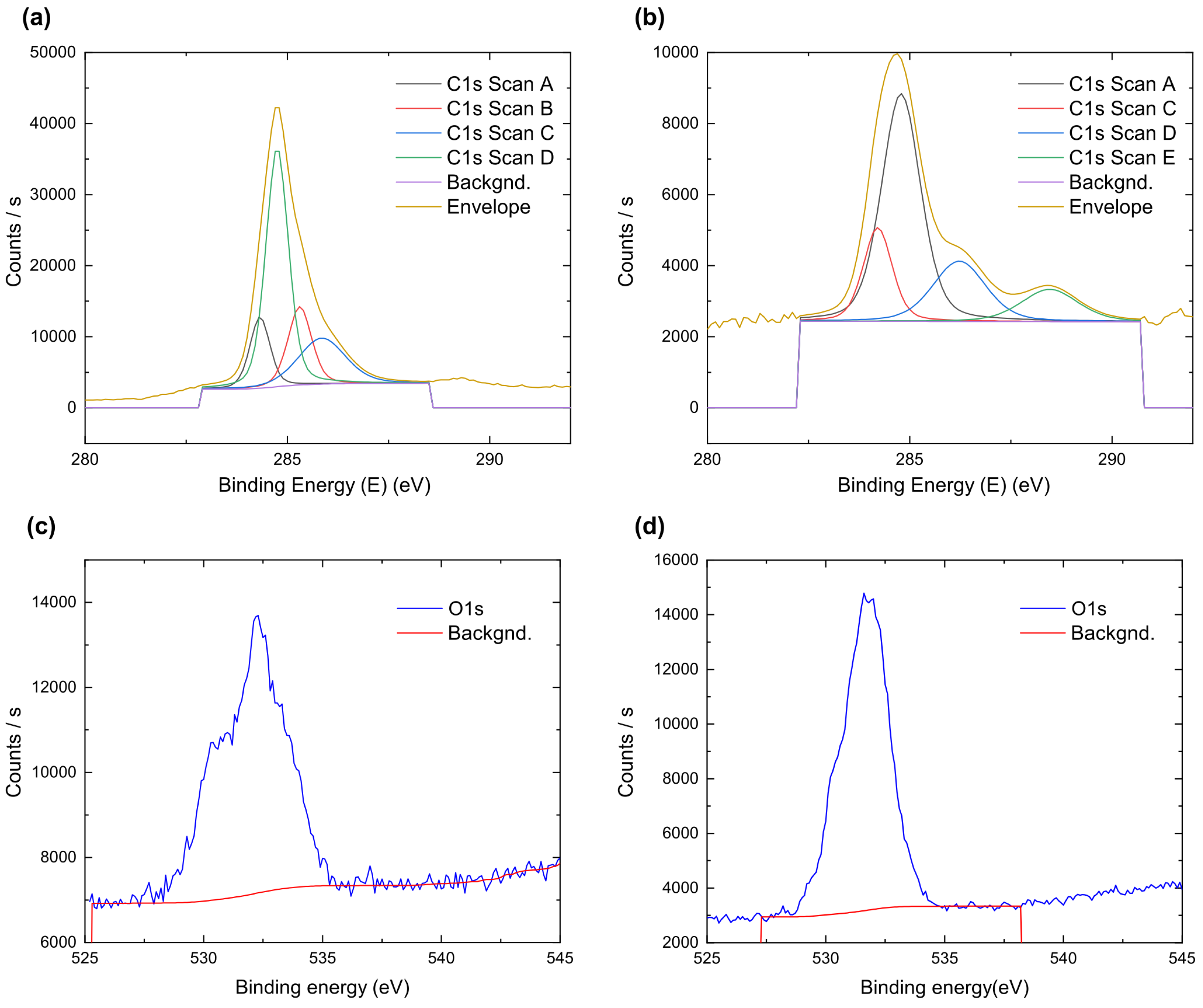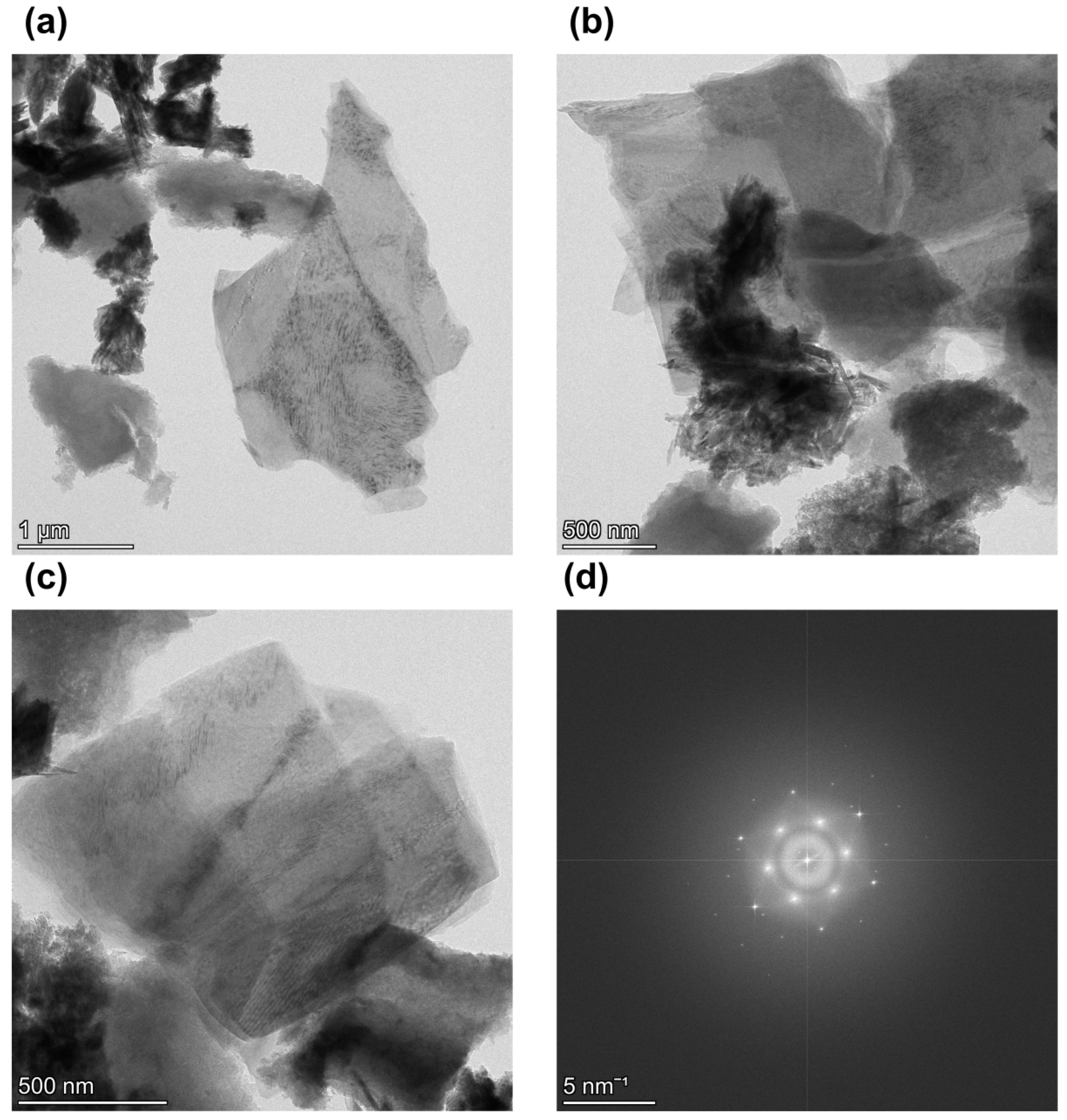Green Extraction of Graphene from Natural Mineral Shungite
Abstract
1. Introduction
2. Experimental Section
2.1. Study of the Physical and Chemical Properties of Shungite
2.2. Extraction of Graphene from Shungite
3. Results
4. Discussion
Supplementary Materials
Author Contributions
Funding
Institutional Review Board Statement
Informed Consent Statement
Data Availability Statement
Conflicts of Interest
References
- Shangguan, Q.; Chen, Z.; Yang, H.; Cheng, S.; Yang, W.; Yi, Z.; Wu, X.; Wang, S.; Yi, Y.; Wu, P. Design of ultra-narrow band graphene refractive index sensor. Sensors 2022, 22, 6483. [Google Scholar] [CrossRef] [PubMed]
- Liu, Q.; Shi, J.; Jiang, G. Application of graphene in analytical sample preparation. TrAC Trends Anal. Chem. 2012, 37, 1–11. [Google Scholar] [CrossRef]
- Jo, G.; Choe, M.; Lee, S.; Park, W.; Kahng, Y.H.; Lee, T. The application of graphene as electrodes in electrical and optical devices. Nanotechnology 2012, 23, 112001. [Google Scholar] [CrossRef] [PubMed]
- Xu, T.; Zhang, Z.; Qu, L. Graphene-based fibers: Recent advances in preparation and application. Adv. Mater. 2020, 32, 1901979. [Google Scholar] [CrossRef]
- Liu, J.; Cui, L.; Losic, D. Graphene and graphene oxide as new nanocarriers for drug delivery applications. Acta Biomater. 2013, 9, 9243–9257. [Google Scholar] [CrossRef]
- Geim, A.K. Graphene: Status and prospects. Science 2009, 324, 1530–1534. [Google Scholar] [CrossRef]
- Li, X.; Yu, J.; Wageh, S.; Al-Ghamdi, A.A.; Xie, J. Graphene in photocatalysis: A review. Small 2016, 12, 6640–6696. [Google Scholar] [PubMed]
- Grigorenko, A.N.; Polini, M.; Novoselov, K. Graphene plasmonics. Nat. Photonics 2012, 6, 749–758. [Google Scholar] [CrossRef]
- Loh, K.P.; Bao, Q.; Ang, P.K.; Yang, J. The chemistry of graphene. J. Mater. Chem. 2010, 20, 2277–2289. [Google Scholar] [CrossRef]
- Soldano, C.; Mahmood, A.; Dujardin, E. Production, properties and potential of graphene. Carbon 2010, 48, 2127–2150. [Google Scholar] [CrossRef]
- Neto, A.C.; Guinea, F.; Peres, N.M.; Novoselov, K.S.; Geim, A.K. The electronic properties of graphene. Rev. Mod. Phys. 2009, 81, 109. [Google Scholar] [CrossRef]
- Zou, X.; Zhang, L.; Wang, Z.; Luo, Y. Mechanisms of the antimicrobial activities of graphene materials. J. Am. Chem. Soc. 2016, 138, 2064–2077. [Google Scholar] [CrossRef] [PubMed]
- Karahan, H.E.; Wiraja, C.; Xu, C.; Wei, J.; Wang, Y.; Wang, L.; Liu, F.; Chen, Y. Graphene materials in antimicrobial nanomedicine: Current status and future perspectives. Adv. Healthc. Mater. 2018, 7, 1701406. [Google Scholar] [CrossRef]
- Wang, Y.; Li, Y.; Tang, L.; Lu, J.; Li, J. Application of graphene-modified electrode for selective detection of dopamine. Electrochem. Commun. 2009, 11, 889–892. [Google Scholar] [CrossRef]
- Priyadarsini, S.; Mohanty, S.; Mukherjee, S.; Basu, S.; Mishra, M. Graphene and graphene oxide as nanomaterials for medicine and biology application. J. Nanostruct. Chem. 2018, 8, 123–137. [Google Scholar] [CrossRef]
- Cao, X.; Yin, Z.; Zhang, H. Three-dimensional graphene materials: Preparation, structures and application in supercapacitors. Energy Environ. Sci. 2014, 7, 1850–1865. [Google Scholar] [CrossRef]
- Liang, M.; Luo, B.; Zhi, L. Application of graphene and graphene-based materials in clean energy-related devices. Int. J. Energy Res. 2009, 33, 1161–1170. [Google Scholar] [CrossRef]
- Mahmoudi, T.; Wang, Y.; Hahn, Y.B. Graphene and its derivatives for solar cells application. Nano Energy 2018, 47, 51–65. [Google Scholar] [CrossRef]
- Pan, Y.; Sahoo, N.G.; Li, L. The application of graphene oxide in drug delivery. Expert Opin. Drug Deliv. 2012, 9, 1365–1376. [Google Scholar] [CrossRef]
- Gupta, S.S.; Sreeprasad, T.S.; Maliyekkal, S.M.; Das, S.K.; Pradeep, T. Graphene from sugar and its application in water purification. ACS Appl. Mater. Interfaces 2012, 4, 4156–4163. [Google Scholar] [CrossRef] [PubMed]
- Das, P.; Ganguly, S.; Banerjee, S.; Das, N.C. Graphene based emergent nanolights: A short review on the synthesis, properties and application. Res. Chem. Intermed. 2019, 45, 3823–3853. [Google Scholar] [CrossRef]
- Lü, K.; Zhao, G.; Wang, X. A brief review of graphene-based material synthesis and its application in environmental pollution management. Chin. Sci. Bull. 2012, 57, 1223–1234. [Google Scholar] [CrossRef]
- Pyun, J. Graphene oxide as catalyst: Application of carbon materials beyond nanotechnology. Angew. Chem. Int. Ed. 2011, 50, 46–48. [Google Scholar] [CrossRef]
- Chabot, V.; Higgins, D.; Yu, A.; Xiao, X.; Chen, Z.; Zhang, J. A review of graphene and graphene oxide sponge: Material synthesis and applications to energy and the environment. Energy Environ. Sci. 2014, 7, 1564–1596. [Google Scholar] [CrossRef]
- Choi, W.; Lahiri, I.; Seelaboyina, R.; Kang, Y.S. Synthesis of graphene and its applications: A review. Crit. Rev. Solid State Mater. Sci. 2010, 35, 52–71. [Google Scholar] [CrossRef]
- Cooper, D.R.; D’Anjou, B.; Ghattamaneni, N.; Harack, B.; Hilke, M.; Horth, A.; Majlis, N.; Massicotte, M.; Vandsburger, L.; Whiteway, E.; et al. Experimental review of graphene. Int. Sch. Res. Not. 2012, 2012, 1–56. [Google Scholar] [CrossRef]
- Young, R.J.; Kinloch, I.A.; Gong, L.; Novoselov, K.S. The mechanics of graphene nanocomposites: A review. Compos. Sci. Technol. 2012, 72, 1459–1476. [Google Scholar] [CrossRef]
- Coleman, V.A.; Knut, R.; Karis, O.; Grennberg, H.; Jansson, U.; Quinlan, R.; Holloway, B.; Sanyal, B.; Eriksson, O. Defect formation in graphene nanosheets by acid treatment: An x-ray absorption spectroscopy and density functional theory study. J. Phys. D Appl. Phys. 2008, 41, 062001. [Google Scholar] [CrossRef]
- Oh, J.S.; Kim, K.N.; Yeom, G.Y. Graphene doping methods and device applications. J. Nanosci. Nanotechnol. 2014, 14, 1120–1133. [Google Scholar] [CrossRef]
- Bucknum, M.J.; Hoffmann, R. A hypothetical dense 3, 4-connected carbon net and related B2C and CN2 nets built from 1,4-cyclohexadienoid units. J. Am. Chem. Soc. 1994, 116, 11456–11464. [Google Scholar] [CrossRef]
- Diederich, F.; Rubin, Y. Synthetic approaches toward molecular and polymeric carbon allotropes. Angew. Chem. Int. Ed. Engl. 1992, 31, 1101–1123. [Google Scholar] [CrossRef]
- Morikuni, Y.; De Silva, K.K.H.; Viswanath, P.; Hara, M.; Yoshimura, M. Rapid and facile fabrication of conducting monolayer reduced graphene oxide films by methane plasma-assisted reduction. Appl. Surf. Sci. 2021, 569, 151022. [Google Scholar] [CrossRef]
- Schniepp, H.C.; Li, J.L.; McAllister, M.J.; Sai, H.; Herrera-Alonso, M.; Adamson, D.H.; Prud’homme, R.K.; Car, R.; Saville, D.A.; Aksay, I.A. Functionalized single graphene sheets derived from splitting graphite oxide. J. Phys. Chem. B 2006, 110, 8535–8539. [Google Scholar] [CrossRef] [PubMed]
- Qi, J.; Zhang, L.; Cao, J.; Zheng, W.; Wang, X.; Feng, J. Synthesis of graphene on a Ni film by radio-frequency plasma-enhanced chemical vapor deposition. Chin. Sci. Bull. 2012, 57, 3040–3044. [Google Scholar] [CrossRef]
- Faggio, G.; Capasso, A.; Messina, G.; Santangelo, S.; Dikonimos, T.; Gagliardi, S.; Giorgi, R.; Morandi, V.; Ortolani, L.; Lisi, N. High-temperature growth of graphene films on copper foils by ethanol chemical vapor deposition. J. Phys. Chem. C 2013, 117, 21569–21576. [Google Scholar] [CrossRef]
- Gao, L.; Ren, W.; Zhao, J.; Ma, L.P.; Chen, Z.; Cheng, H.M. Efficient growth of high-quality graphene films on Cu foils by ambient pressure chemical vapor deposition. Appl. Phys. Lett. 2010, 97, 183109. [Google Scholar]
- Abdelkader, A.; Cooper, A.; Dryfe, R.A.; Kinloch, I. How to get between the sheets: A review of recent works on the electrochemical exfoliation of graphene materials from bulk graphite. Nanoscale 2015, 7, 6944–6956. [Google Scholar] [CrossRef]
- Gebreegziabher, G.; Asemahegne, A.; Ayele, D.; Dhakshnamoorthy, M.; Kumar, A. One-step synthesis and characterization of reduced graphene oxide using chemical exfoliation method. Mater. Today Chem. 2019, 12, 233–239. [Google Scholar] [CrossRef]
- Sutar, D.; Narayanam, P.K.; Singh, G.; Botcha, V.D.; Talwar, S.; Srinivasa, R.; Major, S. Spectroscopic studies of large sheets of graphene oxide and reduced graphene oxide monolayers prepared by Langmuir–Blodgett technique. Thin Solid Films 2012, 520, 5991–5996. [Google Scholar] [CrossRef]
- Nekahi, A.; Marashi, P.; Haghshenas, D. Transparent conductive thin film of ultra large reduced graphene oxide monolayers. Appl. Surf. Sci. 2014, 295, 59–65. [Google Scholar] [CrossRef]
- Yi, M.; Shen, Z. A review on mechanical exfoliation for the scalable production of graphene. J. Mater. Chem. A 2015, 3, 11700–11715. [Google Scholar] [CrossRef]
- Vishwakarma, R.; Zhu, R.; Mewada, A.; Umeno, M. Laser-assisted graphene growth directly on silicon. Nanotechnology 2021, 32, 305601. [Google Scholar] [CrossRef]
- Kumar, R.; Singh, R.K.; Singh, D.P.; Joanni, E.; Yadav, R.M.; Moshkalev, S.A. Laser-assisted synthesis, reduction and micro-patterning of graphene: Recent progress and applications. Coord. Chem. Rev. 2017, 342, 34–79. [Google Scholar] [CrossRef]
- Mishra, N.; Boeckl, J.; Motta, N.; Iacopi, F. Graphene growth on silicon carbide: A review. Phys. Status Solidi (a) 2016, 213, 2277–2289. [Google Scholar] [CrossRef]
- Dresselhaus, M.S.; Dresselhaus, G.; Eklund, P.C. Science of Fullerenes and Carbon Nanotubes: Their Properties and Applications; Elsevier: Amsterdam, The Netherlands, 1996. [Google Scholar]
- Tamburri, E.; Carcione, R.; Politi, S.; Angjellari, M.; Lazzarini, L.; Vanzetti, L.E.; Macis, S.; Pepponi, G.; Terranova, M.L. Shungite carbon as unexpected natural source of few-layer graphene platelets in a low oxidation state. Inorg. Chem. 2018, 57, 8487–8498. [Google Scholar] [CrossRef] [PubMed]
- Rozhkova, N.; Mikhaylina, A.; Rozhkov, S.; Sadovnichi, R. Graphenes, stacks and globules in multiple nanoparticles of shungite carbon and new materials. In Proceedings of the Ninth International Conference “Material Technologies and Modeling”, Ariel, Israel, 25–29 July 2016. [Google Scholar]
- Antonets, I.; Golubev, E.; Shavrov, V.; Shcheglov, V. The model presentation of microstructure, conductivity and microwave properties of graphene-containing shungite. J. Radioelectron. 2017, 9, 1–64. [Google Scholar]
- Rozhkova, N.N.; Rozhkov, S.P.; Goryunov, A.S. Natural graphene-based shungite nanocarbon. In Carbon Nanomaterials Sourcebook; CRC Press: Boca Raton, FL, USA, 2016; Volume 1, pp. 151–174. [Google Scholar]
- Rozhkova, N.N. Shungite-a carbon-mineral filler for polymeric composite materials. Compos. Interfaces 2001, 8, 307–312. [Google Scholar] [CrossRef]
- Rozhkova, N.N. Role of fullerene-like structures in the reactivity of shungite carbon as used in new materials with advanced properties. In Perspectives of Fullerene Nanotechnology; Springer: Berlin/Heidelberg, Germany, 2002; pp. 237–251. [Google Scholar]
- Rozhkova, N. Aggregation and stabilization of shungite carbon nanoparticles. Russ. J. Gen. Chem. 2013, 83, 2676–2685. [Google Scholar] [CrossRef]
- Kovalevski, V.; Buseck, P.R.; Cowley, J. Comparison of carbon in shungite rocks to other natural carbons: An X-ray and TEM study. Carbon 2001, 39, 243–256. [Google Scholar] [CrossRef]
- Kovalevsky, V.; Shchiptsov, V.; Sadovnichy, R. Unique natural carbon deposits of shungite rocks of Zazhogino ore field, Republic of Karelia, Russia. Int. Multidiscip. Sci. GeoConf. SGEM 2016, 1, 673–680. [Google Scholar]
- Khavari-Khorasani, G.; Murchison, D.G. The nature of Karelian shungite. Chem. Geol. 1979, 26, 165–182. [Google Scholar] [CrossRef]
- Kwiecinska, B.; Pusz, S.; Krzesinska, M.; Pilawa, B. Physical properties of shungite. Int. J. Coal Geol. 2007, 71, 455–461. [Google Scholar] [CrossRef]
- Volkova, I.; Bogdanova, M. The shungites of Karelia. Int. Geol. Rev. 1985, 27, 1343–1351. [Google Scholar] [CrossRef]
- Graf, D.; Molitor, F.; Ensslin, K.; Stampfer, C.; Jungen, A.; Hierold, C.; Wirtz, L. Spatially resolved Raman spectroscopy of single-and few-layer graphene. Nano Lett. 2007, 7, 238–242. [Google Scholar] [CrossRef] [PubMed]
- Balta, Z.; Simsek, E.B. Insights into the photocatalytic behavior of carbon-rich shungite-based WO3/TiO2 catalysts for enhanced dye and pharmaceutical degradation. New Carbon Mater. 2020, 35, 371–383. [Google Scholar] [CrossRef]
- Al-Gaashani, R.; Najjar, A.; Zakaria, Y.; Mansour, S.; Atieh, M. XPS and structural studies of high quality graphene oxide and reduced graphene oxide prepared by different chemical oxidation methods. Ceram. Int. 2019, 45, 14439–14448. [Google Scholar] [CrossRef]
- Ederer, J.; Janoš, P.; Ecorchard, P.; Tolasz, J.; Štengl, V.; Beneš, H.; Perchacz, M.; Pop-Georgievski, O. Determination of amino groups on functionalized graphene oxide for polyurethane nanomaterials: XPS quantitation vs. functional speciation. RSC Adv. 2017, 7, 12464–12473. [Google Scholar] [CrossRef]
- Soler-Crespo, R.A.; Mao, L.; Wen, J.; Nguyen, H.T.; Zhang, X.; Wei, X.; Huang, J.; Nguyen, S.T.; Espinosa, H.D. Atomically thin polymer layer enhances toughness of graphene oxide monolayers. Matter 2019, 1, 369–388. [Google Scholar] [CrossRef]
- Akinwande, D.; Brennan, C.J.; Bunch, J.S.; Egberts, P.; Felts, J.R.; Gao, H.; Huang, R.; Kim, J.S.; Li, T.; Li, Y.; et al. A review on mechanics and mechanical properties of 2D materials—Graphene and beyond. Extrem. Mech. Lett. 2017, 13, 42–77. [Google Scholar] [CrossRef]
- Yogesh, G.K.; Shuaib, E.; Roopmani, P.; Gumpu, M.B.; Krishnan, U.M.; Sastikumar, D. Synthesis, characterization and bioimaging application of laser-ablated graphene-oxide nanoparticles (nGOs). Diam. Relat. Mater. 2020, 104, 107733. [Google Scholar] [CrossRef]
- Zhu, L.; Yin, Y.; Wang, C.F.; Chen, S. Plant leaf-derived fluorescent carbon dots for sensing, patterning and coding. J. Mater. Chem. C 2013, 1, 4925–4932. [Google Scholar] [CrossRef]







| Method | Time | Number of Stages | Materials Used | Ref. |
|---|---|---|---|---|
| Chemical methods | 12–24 h | More than 3 | Acids and alkalis | [37,38] |
| Reduction of monolayer | 24 h | More than 3 | Acids and alkalis | [39,40] |
| films of GO | ||||
| Mechanical methods | 4–6 h | More than 5 | Alcohol | [41] |
| Plasma methods | 1–7 min | 1 | N-silicon | [42,43] |
| Growth methods | 10–12 h | 1 | SiC, Ge, acids | [44] |
| Sonication | 2 h | 1 | - | This work |
| Name | Peak | FWHM | Area | Atomic |
|---|---|---|---|---|
| (BE) | (eV) | (CPS·eV) | (%) | |
| C1S scan A sp3 C-C | 284.32 | 0.59 | 7059.83 | 13.25 |
| C1S scan D sp2 C=C | 284.55 | 0.66 | 26,502.12 | 49.73 |
| C1S scan B C=O | 287.31 | 0.69 | 9135.39 | 17.14 |
| C1S scan C C-OH | 285.85 | 1.39 | 10,594.59 | 19.88 |
| Name | Peak | FWHM | Area | Atomic |
|---|---|---|---|---|
| (BE) | (eV) | (CPS·eV) | (%) | |
| C1S scan C sp3 C-C | 284.21 | 0.84 | 1645.01 | 16.29 |
| C1S scan A sp2 C=C | 284.58 | 1.44 | 8709.01 | 53.63 |
| C1S scan E C-O | 286.32 | 1.55 | 3098.99 | 19.09 |
| C1S scan D C-OH | 285.86 | 1.66 | 1783.84 | 10.99 |
Publisher’s Note: MDPI stays neutral with regard to jurisdictional claims in published maps and institutional affiliations. |
© 2022 by the authors. Licensee MDPI, Basel, Switzerland. This article is an open access article distributed under the terms and conditions of the Creative Commons Attribution (CC BY) license (https://creativecommons.org/licenses/by/4.0/).
Share and Cite
Novikova, A.; Karabchevsky, A. Green Extraction of Graphene from Natural Mineral Shungite. Nanomaterials 2022, 12, 4356. https://doi.org/10.3390/nano12244356
Novikova A, Karabchevsky A. Green Extraction of Graphene from Natural Mineral Shungite. Nanomaterials. 2022; 12(24):4356. https://doi.org/10.3390/nano12244356
Chicago/Turabian StyleNovikova, Anastasia, and Alina Karabchevsky. 2022. "Green Extraction of Graphene from Natural Mineral Shungite" Nanomaterials 12, no. 24: 4356. https://doi.org/10.3390/nano12244356
APA StyleNovikova, A., & Karabchevsky, A. (2022). Green Extraction of Graphene from Natural Mineral Shungite. Nanomaterials, 12(24), 4356. https://doi.org/10.3390/nano12244356







